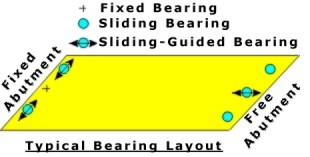

List of Bearing Design Standards - [Show]
• BS EN 1337: Structural Bearings
• PD 6703:2009 Structural Bearings - Guidance on their use
British Standards
• BS 5400: Part 2: Specification for Loads
• BS 5400: Part 9: Code of Practice for Design of Bridge Bearings
Design Manual for Roads and Bridges
• BD37: Loads for Highway Bridges
• BA42: The Design of Integral Bridges
• BD20: Bridge Bearings, Use of BS 5400 Part 9
Choice of Bearings
Bridge bearings are devices for transferring loads and movements
from the deck to the substructure and foundations.
In highway bridge bearings movements are accommodated by the basic mechanisms
of internal deformation (elastomeric), sliding (PTFE), or rolling. A large
variety of bearings have evolved using various combinations of these mechanisms.

Elastomeric Bearing

Plane Sliding Bearing

Multiple Roller Bearing
Design Considerations
The functions of each bearing type are :
Elastomeric
The elastomeric bearing allows the deck to translate and rotate, but also resists loads in the longitudinal, transverse and vertical directions. Loads are developed, and movement is accommodated by distorting the elastomeric pad.Plane Sliding
Sliding bearings usually consist of a low friction polymer, polytetrafluoroethylene (PTFE), sliding against a metal plate. This bearing does not accommodate rotational movement in the longitudinal or transverse directions and only resists loads in the vertical direction. Longitudinal or transverse loads can be accommodated by providing mechanical keys. The keys resist movement, and loads in a direction perpendicular to the keyway.Roller
Large longitudinal movements can be accommodated by these bearings, but vertical loads only can generally be resisted.
The designer has to assess the maximum and minimum loads that the deck will exert on the bearing together with the anticipated movements (translation and rotation). Bearing manufacturers will supply a suitable bearing to meet the designers requirements.

Bearings are arranged to allow the deck to expand and contract, but retain the deck in its correct position on the substructure. A 'Fixed' Bearing does not allow translational movement. 'Sliding Guided' Bearings are provided to restrain the deck in all translational directions except in a radial direction from the fixed bearing. This allows the deck to expand and contract freely. 'Sliding' Bearings are provided for vertical support to the deck only.
